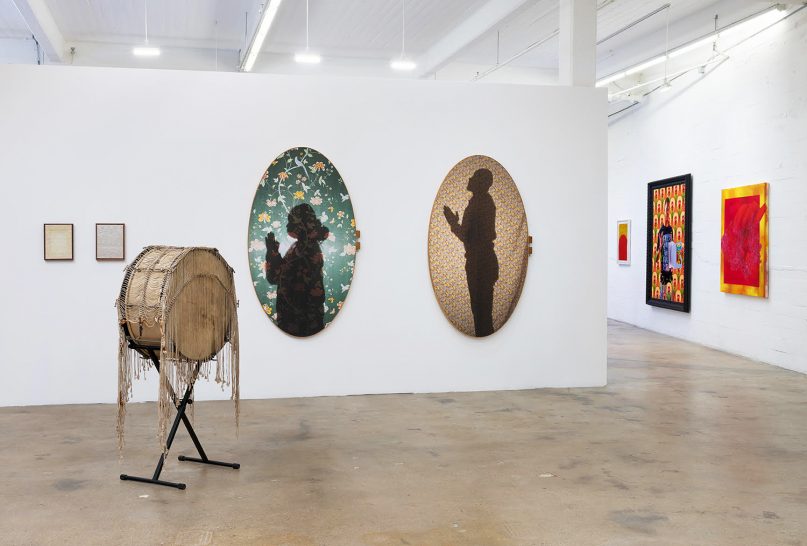LOS ANGELES (RNS) — Two Los Angeles art exhibitions are exploring Black spirituality and worship, coinciding with the 115th anniversary of a series of revival meetings in the city, considered to be the launch of the Pentecostal movement.
“Enunciated Life” runs through Aug. 15 at the California African American Museum in South Los Angeles and features the “movements, sounds and other bodily expressions” that embody Black spiritual beliefs.
Bridge Projects’ “Otherwise/Revival” is open until June 26 in Hollywood and visualizes the impact of the Black church, specifically the Pentecostal movement.
The titles of the two retrospectives are derived from author Ashon T. Crawley, whose book “Blackpentecostal Breath” explores how the practices of Pentecostalism empower “otherwise” modes of existence.
RELATED: How Azusa Street ignited a global Holy Spirit movement
The way Crawley sees it, Black Pentecostalism has the power “to enunciate life, life that is exorbitant, capacious, and fundamentally social, though it is also life that is structured through and engulfed by brutal violence.”
During what is now known as the Azusa Street Revival, the Pentecostal movement was birthed in 1906 — not on Azusa Street, but in a house on Bonnie Brae Street where the Rev. William J. Seymour, a Black pastor, preached for weeks about baptism in the Holy Spirit — the belief that Christians can receive empowerment beyond their first baptism to hear and speak in a spiritual language called tongues.
As word spread and crowds became larger, Seymour moved the group to a building used to shelter livestock at 312 Azusa St., where thousands of people worshipped daily for nearly three years. The multiracial movement overcame differences in class, gender and race to unite around the belief that the Holy Spirit still works miracles.
As part of the California African American Museum’s exhibition, Gastón Espinosa, professor of religious studies at Claremont McKenna, and Marne L. Campbell, professor and chair of African American studies at Loyola Marymount, joined the museum’s history curator Susan D. Anderson in a panel Tuesday (April 13) to discuss the history and significance of Black Pentecostalism.
Espinosa described Pentecostalism as “one of the most important religious movements of the 20th century,” with hundreds of millions of people around the world tracing their roots back to the LA revival.
“It crosses racial boundaries, linguistic boundaries, cultural boundaries,” he said during the panel.
To Campbell, focusing on Black Pentecostalism is significant because it is often overlooked in discussions surrounding the Black church.
“People who focus on the ‘Black Church’ tend to focus less on those groups who are outside of the AME or Baptist churches,” Campbell told Religion News Service via email.
RELATED: Henry Louis Gates’ new book and TV series distills centuries of Black church history
In “Enunciated Life,” commissioned works by Shikeith, Billy Mark and Tiona Nekkia McClodden “draw upon the choreography and sonics of possession found in Black spirituality,” including the “visible signs of embodied surrender, such as sweating, whooping, shouting, back-bending, and chest-opening,” according to the description of the exhibition.
CAAM’s exhibition, curated by Taylor Renee Aldridge, features 13 Black artists — who through video, painting, photography and installation — explore the “bodily experiences that transpire through religion.”
“Otherwise/Revival” at Bridge Projects features 31 mostly Black artists, some who grew up in the Black Pentecostal Church and others who were raised Catholic or another denomination. Some didn’t grow up religious. The work of all the artists, however, “embodies the spirit of revival,” said the show’s curators Jasmine McNeal and Cara Megan Lewis in a statement.
Kehinde Wiley, Angela Bryant, Phyllis Stephens and Kenturah Davis are among the artists featured.
Through sculptures, paintings, video and performances, the artists “celebrate the significance of music, praise, breath, and community” and reflect on their own traditions, heritages and passions, McNeal and Lewis said.
“Otherwise/Revival,” for example, highlights the Pentecostal background of Stephens, an award-winning fifth-generation quilt maker.
In a statement about her new quilt “High and Lifted Up,” Stephens said: “As a child I attended a Pentecostal church, and it was there I learned to cry out to God from the depths of my soul. I was sure heaven heard my every cry. In God there are no limits and all things are possible — if you believe,” according to Bridge Projects.
McNeal said the exhibit was a year in the making and was stalled due to the pandemic.
To McNeal, this exhibit comes at a time when “people want to hear the truth.”
“They want to learn more about Black history and movements, but they also want to learn more about spirituality and they’re more vocal about what that means for everyone.”
The California African American Museum and Bridge Projects are now open to the public.





